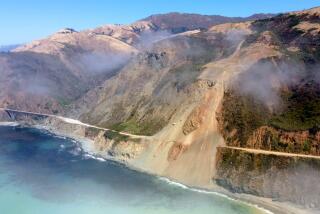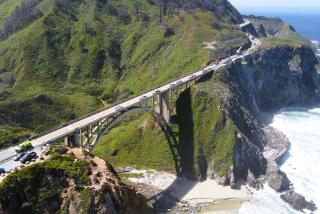Wretched Roads Another Legacy of El Nino’s Wrath
- Share via
Homes were sliding down hills, entire beaches were heading out to sea, and local carwashes were losing upward of 40% of their customers during this spring’s rains.
And motorcyclists were enduring an El Nino-driven calamity of their own--one so awful that it could be exceeded only by a nasty slide on a freshly painted Ninja, perhaps, or a high-noon flat in the middle of the Mojave: Some of the very best riding roads in Southern California were washing away or being buried in mudslides.
Well into the summer riding season, some of those roads are still out of commission. And many of the ones that have been reopened still exhibit the potentially dangerous scars of an El Nino year, from a light dusting of sand on blind curves to small rockslides and big potholes.
From February through early May, the California Department of Transportation spent $36 million in Federal Emergency Management Agency funds fixing storm-damaged roads, with workers racking up 92,000 overtime hours, said Caltrans spokeswoman Jeannie Bonfilio. And there’s as much as $16 million worth of repairs yet to be made.
“They get mad when we close the highways . . . but we’re out there really working hard, sometimes around the clock, trying to get them back open,” Bonfilio said.
*
Perhaps the single greatest riding washout of the season has been California 33, where the steep and winding two-laner cuts through the cliffs of Los Padres National Forest north of Ojai. A February deluge sent more than 1 million cubic yards of earth sliding across the road, and crews are still at work clearing the route and repairing damage to the roadway.
The highway is blocked at Wheeler Springs on the south end and near the Ozena Ranger Station on the north and will remain closed until mid-August.
The Pacific Coast Highway (California 1) was knocked out numerous times in numerous places, including a stretch at Big Sur that remained closed from Feb. 2 to May 20, costing Monterey County an estimated $41 million in tourism losses. But PCH is once again open from Mexico to Oregon. Sort of.
Several stretches are still being rehabilitated, with traffic frequently halted to allow heavy equipment to enter and exit the roadway. Traffic is escorted through other stretches, where just one lane is open. And during certain hours on certain stretches, only locals can travel the highway.
The wise rider planning a trip on the famed roadway will factor in some waiting and slow-riding time--then factor in some more.
*
Elsewhere, the beloved Angeles Crest Highway (California 2), wending its way north through the San Gabriel Mountains from La Canada Flintridge, was reopened last week after being closed for much of its length for most of the spring.
Like many other favorite cycling byways--including Mulholland Highway, Big Tujunga Road and most of the canyon roads around Malibu--the Crest Highway was thrashed like an Evel Knievel practice bike and should be ridden with extra caution.
Indeed, El Nino’s most enduring legacy for motorcyclists may be bent, cracked, pocked and dirty roads rather than closed ones.
Around many of the Crest Highway’s sharp corners one recent afternoon, patches of sand lay hidden in the lengthening shadows. In other places, the roadway was wet and covered with small stones, the remnants of the most recent runoff. Both are minor hazards for the driver of a four-wheeled vehicle, of course, but they’re potentially deadly for the unprepared motorcyclist.
“You have to be more conservative in your riding” this year, said Leon Bellissimo, owner of Kawasaki of Burbank. Bellissimo has gone so far as to choose a Vespa for a few rides this season, noting that the scooter “handles corners really well.”
“But they only have 10-inch wheels,” he says, “so you don’t want to hit a pothole.”
*
Even before heading out on a nice, cautious ride, be it on a Vespa, a Honda Goldwing or anything in between, check your rubber, experienced riders say.
“You don’t want to cheap-out on tires--that’s No. 1,” said Pranav Mulani, parts and service manager at Suzuki of Van Nuys. “If you hit even a little bit of sand on bald tires, you’ll go down.”
Other suggestions for remaining upright include staying clear of the edge of the lane on the uphill side, where debris and water are most likely to accumulate, and being on the lookout for wildlife on the roadway. With snow still covering foliage at higher elevations, deer have been traversing popular, low-elevation riding roads frequently.
Most important, though, is to ease up on the throttle a bit. And the next time a road worker turns the “SLOW” sign around to “STOP” as you approach, brake and smile. The poor guy may have an overtime-laden bank account, but he probably can’t get a day off to spend his dough.
*
Eric Slater, a Times staff writer based in the San Fernando Valley, rides a 20-year-old Harley-Davidson Sportster. He can be reached via e-mail at eric.slater@latimes.com.
ROAD WORRIERS
Given the general state of coastal and mountain roads, riders are advised to check conditions in advance. One resource for current conditions is the Caltrans Web site: https://www.dot.ca.gov/hq/roadinfo/.
More to Read
Sign up for Essential California
The most important California stories and recommendations in your inbox every morning.
You may occasionally receive promotional content from the Los Angeles Times.













